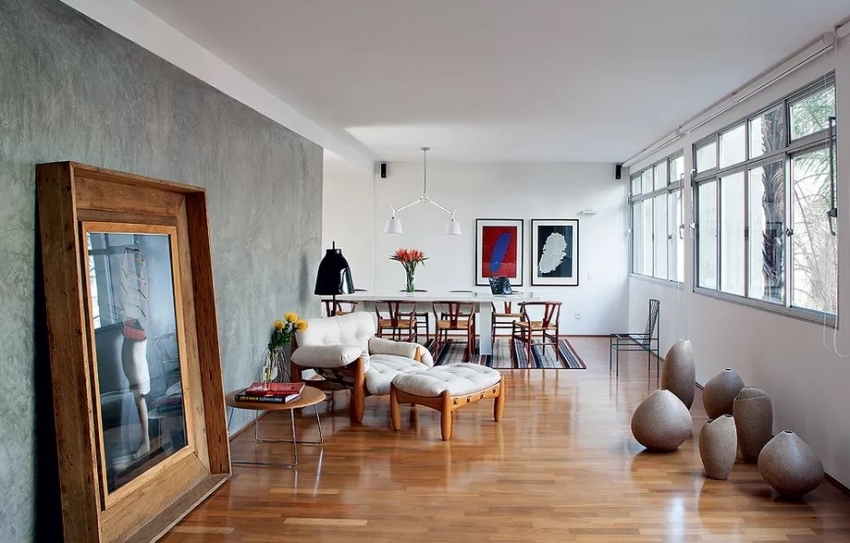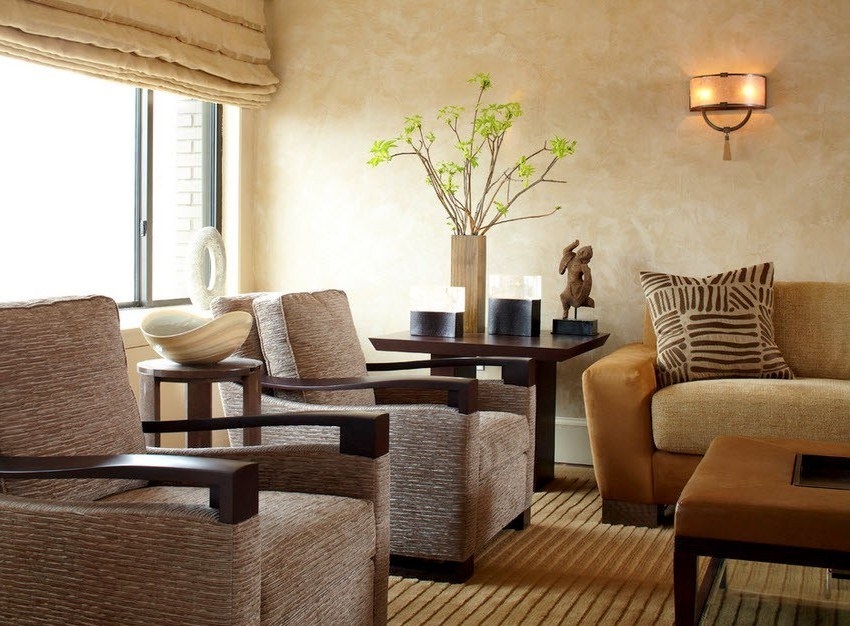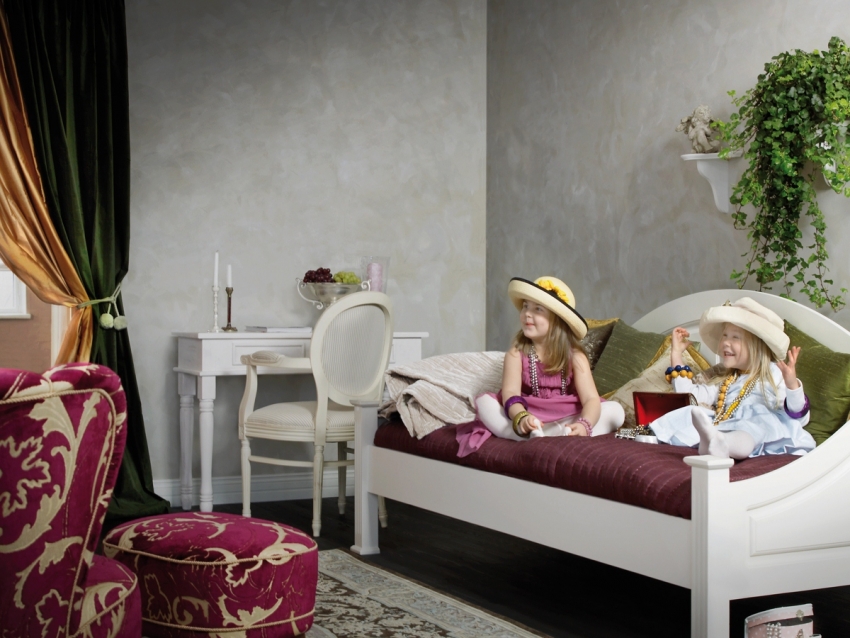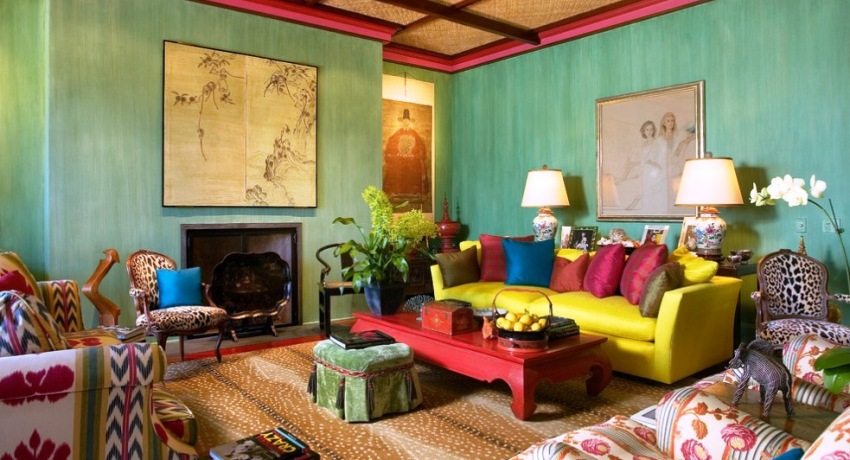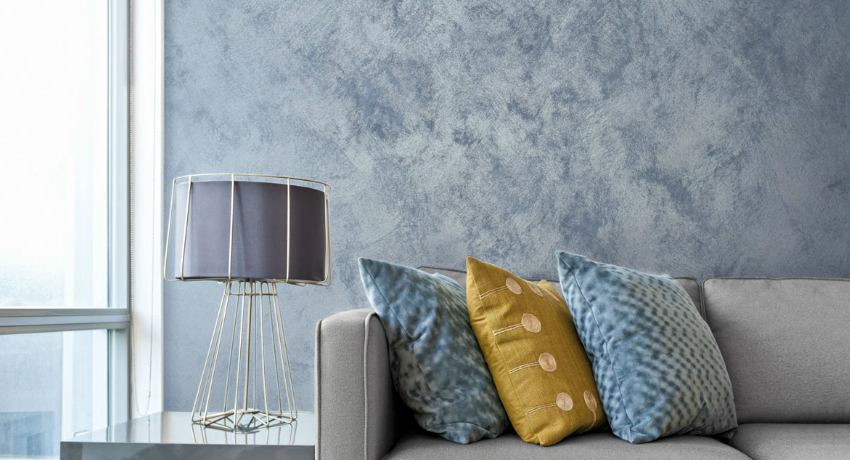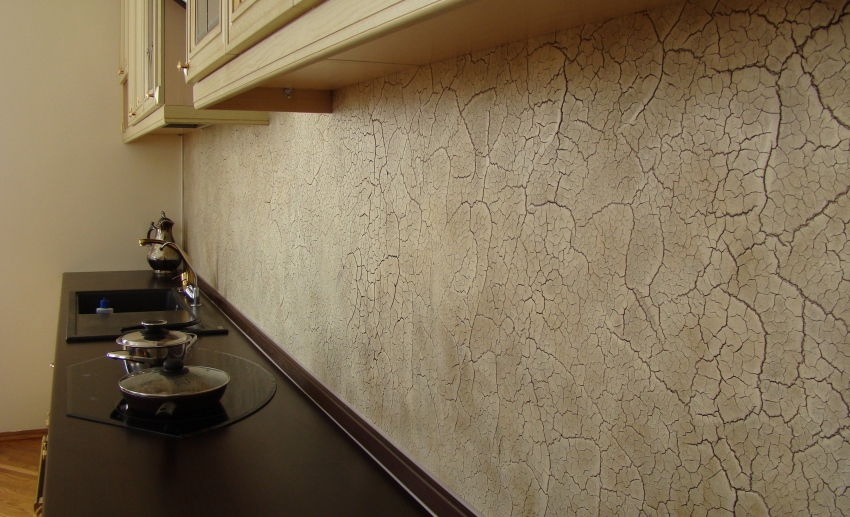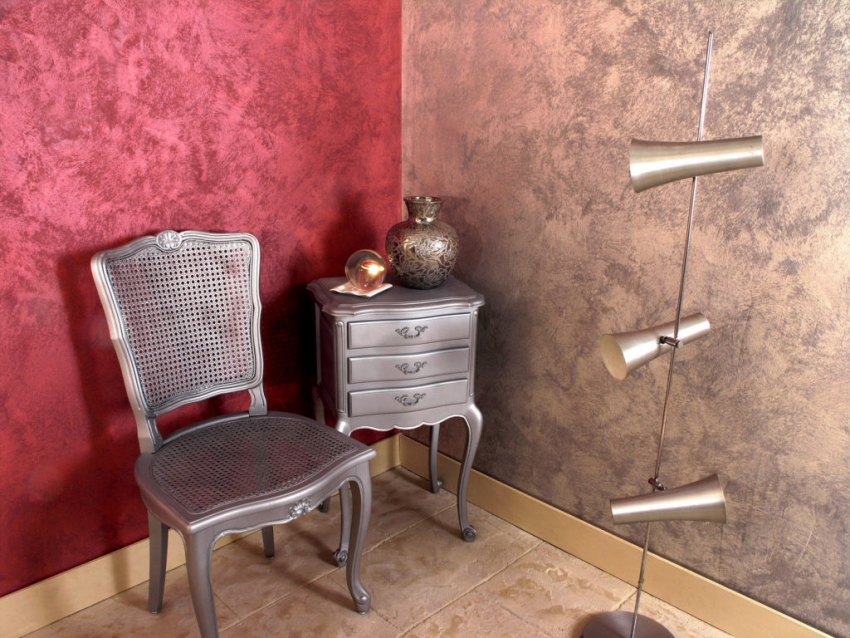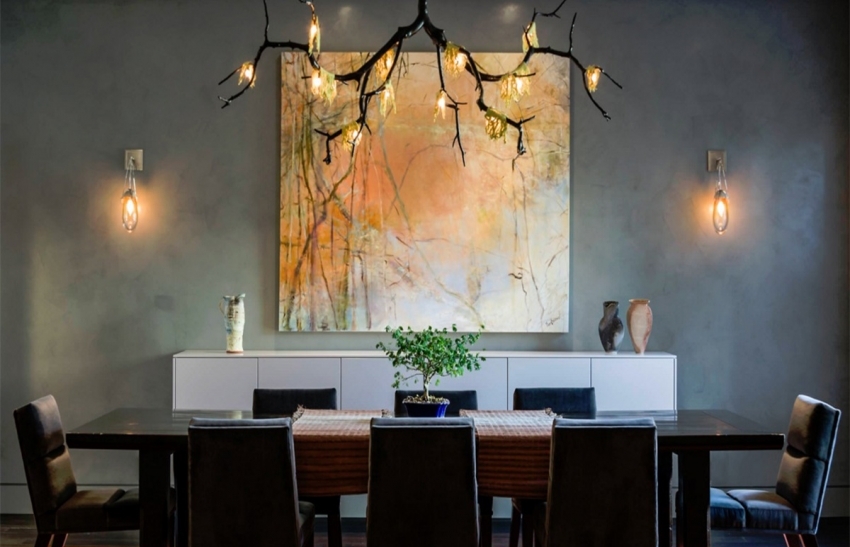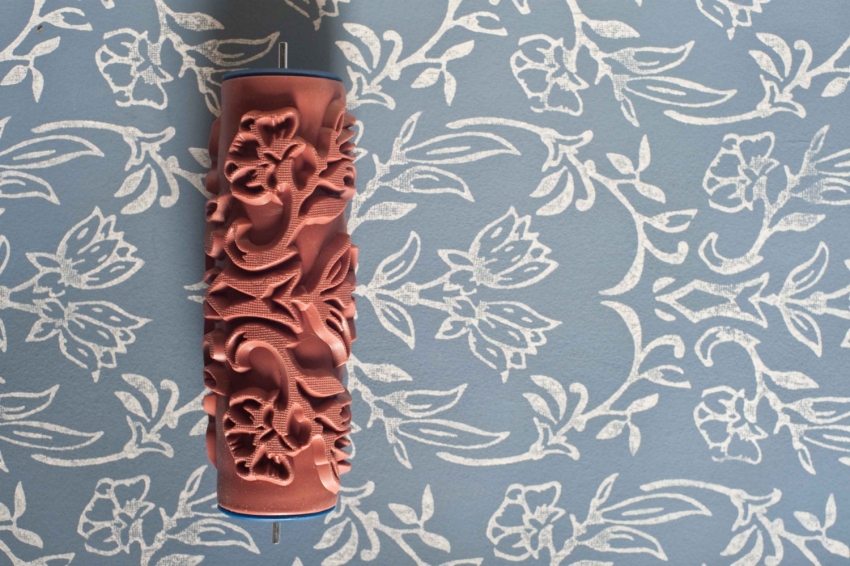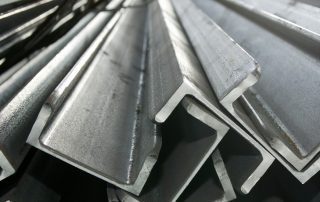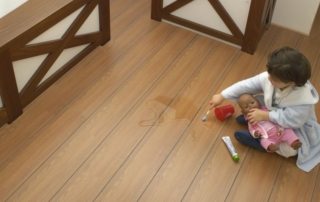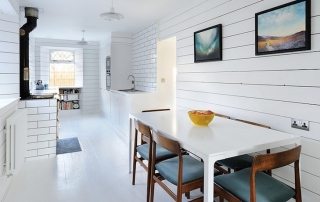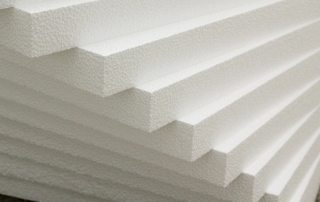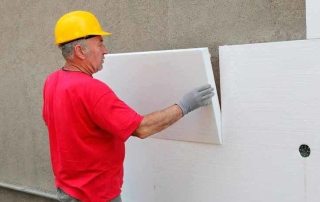From this article you can learn about all the features that textured wall paint used in modern interiors possesses: properties of the finishing material, its advantages and disadvantages, varieties, popular effects that can be created using the coloring composition, prices. The process of preparing the walls and detailed technology for applying textured paint, including photo and video materials, will be considered.
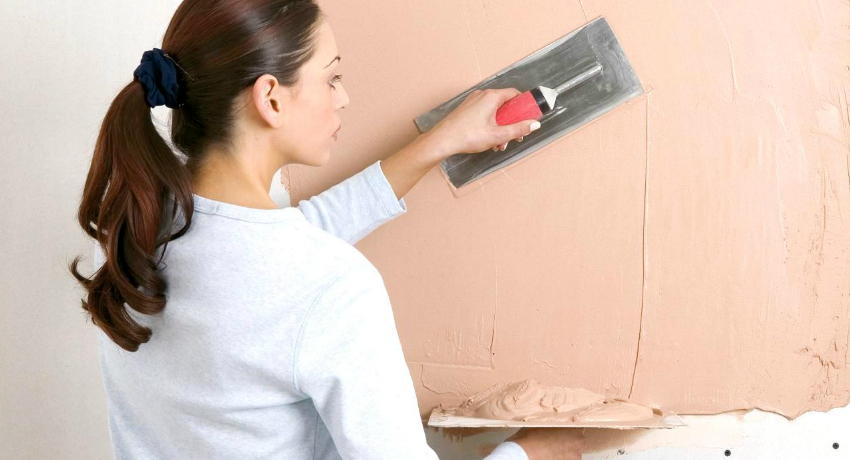
With the help of textured paint, you can achieve both a perfectly flat surface and give the wall a unique decorative look
Content [Hide]
- 1 Textured wall paint as a finishing material
- 2 How to paint the walls in an apartment with textured paint: photos of interesting design options
- 2.1 What paint to paint on the walls: choosing the optimal dye
- 2.2 Standard textures of decorative wall paint: photo examples and features of the compositions
- 2.3 Unusual effects of textured wall paint: photos and features of the compositions
- 2.4 Characteristics of the decorative sand effect wall paint
- 2.5 Buying textured wall paint: the price of textured compositions
- 3 How to apply decorative wall paint: video review of technology and recommendations
- 4 Create decorative finishes with brushes, trowels and wall paint rollers
- 4.1 The procedure for preliminary preparation of walls for painting
- 4.2 Features of applying liquid decorative paint for walls in an apartment
- 4.3 Wall painting technology with decorative paint: the use of dry composition
- 4.4 Methods for decorating paint for interior wall decoration
- 4.5 How to apply textured wall paint: video tips and tricks
Textured wall paint as a finishing material
Textured or textured wall paint can be classified as one of the decorative finishes, thanks to which you can create beautiful embossed patterns on the treated surfaces. This became possible due to the special composition and density of the material. The coloring composition can have a creamy consistency, or it can be a thick viscous mass made using acrylic components.
To some extent, textured paint can replace paint and varnish and finishing plaster. In this case, there is no need to carefully level and plaster the surface. It is enough to putty the walls for painting in areas where there are large cracks and deep pits, and then apply a coating in the form of acrylic impregnation.
Note! Painting that gives surfaces a textured effect can be used for more than just decorative finishes.This material perfectly hides small defects on the walls that ordinary paint or wallpaper cannot mask.
Varieties of decorative paints for walls in an apartment
Structural dyes are available for sale in two versions:
- Liquid formulations are completely ready for use. They already have the required shade, so there is no need to use a color scheme.
- Dry - the second name of these compounds sounds like decorative plaster. This type of dye is diluted with water and dye is added to give the desired shade.
Acrylic latex used in the production of textured paints undergoes polymerization during evaporation and absorption of water. Due to this, the drying time of the dye is only 1-2 hours. As a result of using the material in its pure form, a finishing layer 0.2-2 mm thick is formed on the surface. If you add additional components such as sawdust, sand and other materials to the dye, you can increase the layer thickness to 0.7-1 cm.
When using additional components, the compound can be used as a plaster for leveling small damages on walls (up to 2 mm deep). Due to the fact that the aqueous solution of acrylic penetrates deep into the treated surface, which can be made of concrete, brick and covered with plaster, the adhesive properties of such paint can be compared with the capabilities of most cement mortars.
After the polymerization process is completely completed, the surface of the acrylic material acquires water-resistant properties. For this reason, many textured dyes are suitable not only for interior, but also for exterior decoration.
Note! Textured decorative paint for interior wall decoration can be safely used to decorate the design of a bathroom or kitchen, where the level of humidity is increased. After the composition has dried, the surfaces will be reliably protected from mold and moisture.
Types of fillers in structured wall paint
Density and relief is provided by particles that are included in the dye. Textured finishing materials are also classified according to the type of fillers, which can be:
- crushed gas silicate;
- marble or granite chips;
- metal particles with a reflective surface;
- quartz sand;
- fibers of natural or synthetic origin;
- sawdust.
Also, the composition may contain modified starch as a thickener and special pigments, thanks to which you can get wall paint with the effect of silk or pearlescent coating. Most often, these particles are in the form of droplets or flakes.
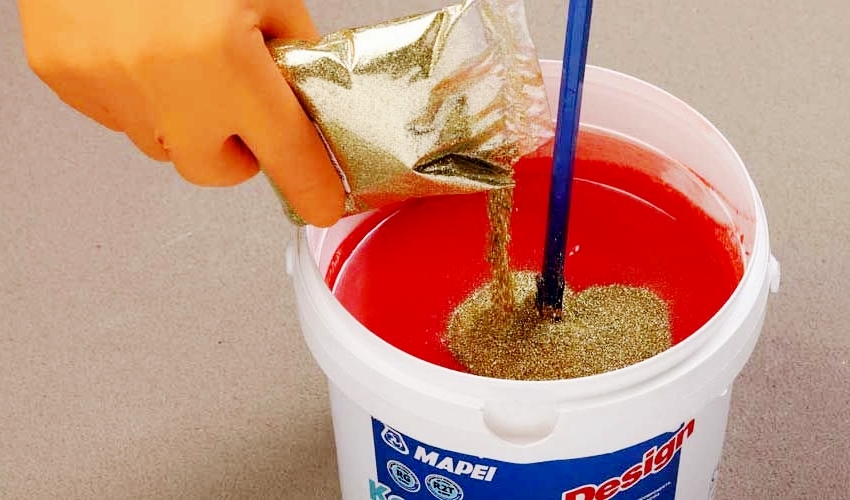
Some types of paints have additions - glitters, scales, pile and other materials, which, as a result, will beautifully be beautifully distributed along the wall
The relief of the dye and the depth of its structure depends on the size of the filler particles:
- Fine-grained dyes - are created on the basis of filler particles with a diameter not exceeding 0.5 mm.
- Medium-grained compositions - include particles of 0.5-1 mm in size.
- Coarse-grained dyes - the composition contains fractions with a diameter of 1-2 mm.
Before you buy graphite wall paint or another version of the dye, you should read the manufacturer's recommendations for use. Plaster, wood, brick or stone masonry, concrete surface can be used as a basis for applying the dye.
Disadvantages of interior paints for walls and ceilings
The main distinguishing feature of textured dyes from compositions that form a smooth surface is decorativeness.Structural paints can achieve amazing effects. On sale there are options that imitate various types of natural surfaces and materials:
- sand;
- wood;
- a rock.
Note! Material consumption is about 1 kg / m². Before making a purchase, it is worth calculating the budget in advance, since the total cost of finishing can be very high, because the price of decorative wall paint, especially with unusual effects, is much higher than that of wallpaper or standard dyes.
Despite the fact that painting can be carried out on top of the finishing putty, wood panels, chipboard, glass, plywood, metal and gypsum board (gypsum plasterboard), the base still requires preparation. A high-quality result is possible only if the surface of the base is flat and clean. In addition, certain skills may be required to create a creative design. This is where the disadvantages of finishing end.
Advantages of interior paints for walls and ceilings
Advantages of decorative paint finishes:
- long service life - the average is 10 years, while high-quality wallpaper can last about 5 years;
- the ability to renew the coating by applying a new layer of paint without the need for preliminary removal;
- environmental friendliness and safety;

To create special effects when using textured paint, you must use additional tools - a roller, sponge or a special spatula
- resistance to mechanical stress and exposure to sunlight. The surface does not provoke the development of mold;
- the ability to create a monolithic coating;
- easy care system due to the washable surface. At the same time, the paint repels dirt well. This advantage is especially relevant for corners and areas around switches;
- the choice of design solutions, shades and textures will not force the buyer to think about how to get an unusual effect. Even the most sophisticated will find suitable options for their home;
- the material gives you complete freedom to experiment. You can choose different shades or reliefs. Textured paint is applied in layers using special rollers or spatulas. The choice of instrument depends on what effect you want to get;
- the versatility of the paint allows you to use it to decorate the walls of the living room, kitchen, children's rooms, bathrooms;
- rich appearance;
- unique textured pattern;
- the decorative coating has antistatic properties, due to which dust is repelled from the surface;
- good vapor permeability of the coating, which does not create obstacles to the movement of air masses in the room.
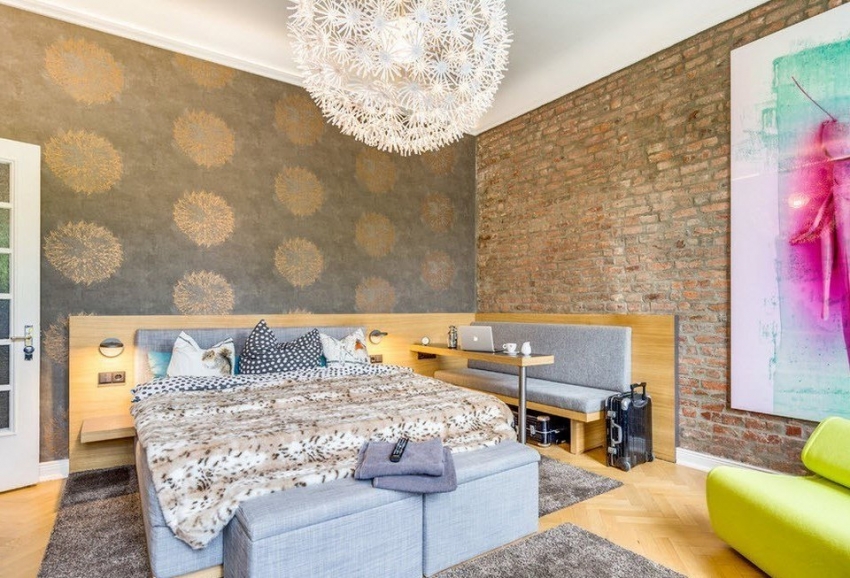
Some types of texture paints require several layers of application of different shades and structures.
How to paint the walls in an apartment with textured paint: photos of interesting design options
As a result of painting the walls with textured paint, it becomes possible to create an exquisite and unique interior. Each dye composition has its own grain. The deeper and more expressive the texture should be, the greater the granularity of the filler should be selected. This indicator is indicated by the manufacturer on the packaging.
Useful advice! Before proceeding with the direct application of paint, it is better to practice on a small section of the wall or a piece of plywood. If a wall is used as the basis for the sample, the layer of the coloring composition applied during training must be removed after finishing with a steel spatula. Then the surface of the wall should be dried and covered with a primer.
What paint to paint on the walls: choosing the optimal dye
The most important criterion for choosing a textured wall covering is the base of the dye.Taking into account this parameter, several types of finishing materials are distinguished for creating textures.

In order for the paint to have an attractive appearance for a long time, you should take care of the high-quality preparation of the wall before painting.
Silicone paint - the most common type of dye for exterior and interior use. The material allows you to create a vapor-proof coating that is resistant to negative environmental factors (aggressive external influences, moisture, temperature changes).
Mineral dye - the cheapest dry powder finish. The material contains lime and cement. Most often, the dye is used to decorate the exterior walls of a building.
Silicate composition - is considered the most expensive option, while it is practical to use. The coating is absolutely not afraid of external influences, is easy to clean and perfectly repels dust particles and dirt. The material must be used with a primer with a similar base.
Acrylic paint - comes ready-made, so it is very convenient to use. It is allowed to add fillers necessary to create a certain effect, as well as colors for color correction.

One of the most modern and fashionable design trends is the use of textured paint with a stone effect
Standard textures of decorative wall paint: photo examples and features of the compositions
There are several basic textures that can be obtained with texture paint.
Embossed texture - the formation of such a coating is carried out due to special fillers in the composition of the dye. The application technology is very simple, so even a person with no experience can handle the work.
Related article:
Versatile material: liquid wallpaper, how to apply it to walls and other surfaces
What is liquid wallpaper and how are they beneficial. Preparation of the composition of liquid wallpaper and the technology of application to the wall and ceiling.
Misuri - it will take a lot of effort to create this type of coating. This requires a textured paint made on an acrylic base with the addition of modified starch. With the help of this composition, you can create not only a textured, but also a flat surface.
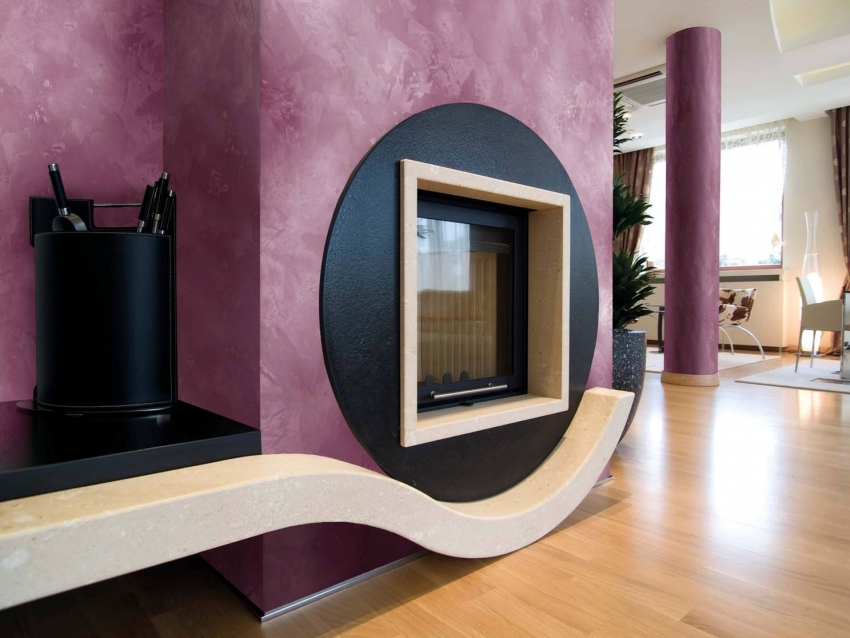
The method of applying textured paint "Atacama" has a fascinating effect - in day and evening lighting, the walls look different, while being very pleasant to the touch
Marseille wax - the finish is sophisticated and stylish, but professional knowledge and skills are required to create it. Using the material, you can make a realistic imitation of cork, wood bark or aged stone. To obtain a deep rich color, the finish is coated with a special decorative wax. The material is suitable for both interior and exterior walls. It can be used in bathrooms and living rooms, as well as in office premises, restaurants, swimming pools.
Atacama - a special way of applying the coloring composition. The surface acquires a fascinating reflective effect if quartz sand of the required fraction and metallic pigments are added to the base. Essentially, it looks like a velvet-effect wall paint that has a shimmery and soft finish.
Useful advice!The best paint application results are obtained when both the base and the composition itself are at room temperature.
Unusual effects of textured wall paint: photos and features of the compositions
There are special types of paints that have an unusual design effect, creating exquisite textures on the surface.Wall paints with the effect of silk or mother-of-pearl look very impressive on the photo. This type of finish fills the space with light. This advantage is especially true for the winter and autumn periods, when the weather is cloudy outside the windows.
Depending on the type of lighting, as well as the viewing angle, the mother-of-pearl or silk coating can change its shade. Thanks to this, the decoration received a second name - chameleon. When using decorative wall paint with a silk effect, it feels like the surface looks like a stretched silk cloth. This type of finish has a characteristic pearl luster, which is due to the presence of special pigment additives in the dye.
Experts also recommend buying pearlescent wall paint to create a wet silk effect. For this, the mixture is applied using a brush with a coarse nap or roller. The technique involves the formation of random stains on the surface of the wall.
Granite colorant, despite its name, does not contain granite chips. The realistic imitation of the texture is due to acrylic bubbles formed from paints of different shades. This type of dye is applied to the surface using a special tool - spray gun... As a result, the bubbles burst, creating a beautiful texture.
Characteristics of the decorative sand effect wall paint
Particularly popular is textured paint that imitates a sandy surface. The composition of such a material may be different, it depends on the manufacturer.
Most often, manufacturers add particles to the composition of paint with a sand effect:
- quartz sand;
- seashells;
- sequin.
In addition, the modern assortment allows you to purchase pearlescent and matte wall paints that imitate the surface of sand. In the first case, the paint contains reflective particles, in the second, the coating turns out to be rough and velvety.
Note! The pearlescent dye is environmentally friendly. The composition is made from acrylic resin and glitter pigment. The dye contains natural pearlescent grains extracted from sea shells. Even if the wall is exposed to strong heat, no harmful substances will be released from the dye into the air.
Pearlescent textured paint is recommended for wall decoration in rooms that are often used throughout the day. The glossy surface adds dynamism to the interior.
There are no additional additives in the matte dye. This type of finish is best used when you want to create walls with a light sandy texture. The matte surface transforms the interior, making its shades soft and elegant. When the sun's rays hit such walls, there is little light scattering. This makes the imperfections of the substrate invisible.
Buying textured wall paint: the price of textured compositions
Many manufacturers produce universal formulations with excellent performance characteristics. Thanks to this, you can buy textured interior wall paint, which is perfect for finishing the facade of the building. On the example of the San Marco brand, a variety of unusual Italian finishing materials made from natural raw materials are shown.
Average price of textured paints from the San Marco company:
| Coating name | the effect | price, rub. |
| Velatur | aged surface | 2015 |
| Marco Polo | metal surface | 2665 |
| Marcopolo Luxeri | fine texture of non-ferrous metals | 2730 |
| Unimark Smalto Mikacheo | polychrome surface with mica | 2743 |
| Riflessie | translucent mother of pearl | 2925 |
| Decor Classic | acrylic granules for creating different textures | 2938 |
| Cadoro | iridescent moire silk | 3088 |
| Perlacheo | chromatic surface (pearlescent additives and modified siloxane polymers) | 3380 |
| Cadoro Velvet | soft corduroy | 3426 |
| Easy Art | iridescent metal | 3770 |
| Cavenier | nacre | 4128 |
| Lunanuova | reflective multicolor crystals | 4225 |
| Via Dela Seta | velvety water-based texture | 4641 |
| May Art | translucent finish coat | 7150 |
How to apply decorative wall paint: video review of technology and recommendations
To work with textured paint, you will need a certain set of tools. Before starting work, you should take care of the availability:
- containers of a suitable size (basin or bucket);
- construction mixer (you can use a drill with a special attachment);
- a set of paint brushes of different sizes and with different nap hardness;
- foam or natural sponge;
- spray gun;
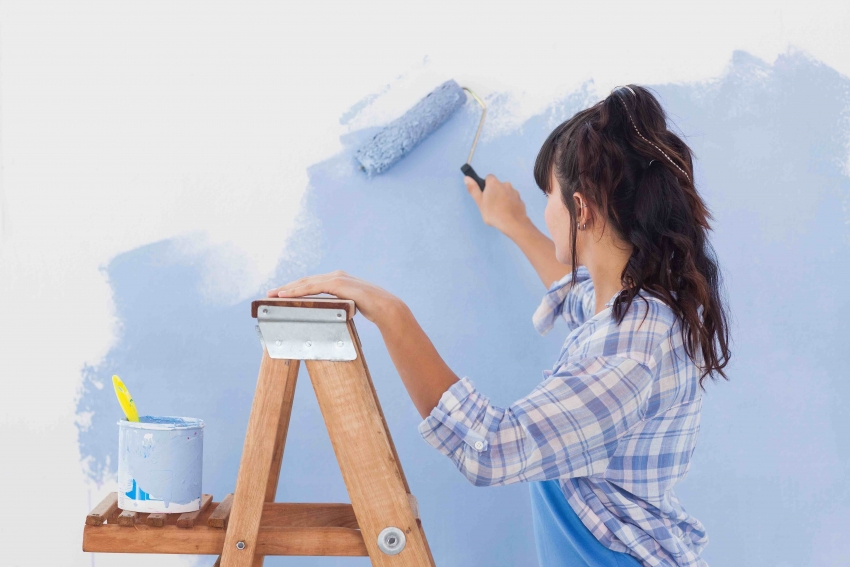
Depending on the desired result, when painting, you can use several types of tools and materials at hand
- a set of spatulas;
- paint rollers;
- trowel;
- rules (length 2-3 m);
- graters;
- cellophane film and protective equipment (gloves, glasses, long-sleeved clothing, bandanas or caps).
Useful advice!You can use a pneumatic spray gun to get the original paint on the walls. Having filled the instrument with paint of the required color, you need to set the pressure at around 5 atmospheres and install a nozzle with a diameter of 0.3-0.5 cm on the device.
Create decorative finishes with brushes, trowels and wall paint rollers
The texture depends not only on the dye itself, but also on the instrument chosen for its application. For these purposes, rollers, spatulas, brushes, combs and even improvised means can be used:
- stiff wide brush - you can apply the material to the wall using vertical, cross, horizontal, wavy and other movements;
- comb - used for a more pronounced relief with a rare pattern. It is used in the same way as a brush;
- spatula - a thin layer of dye is applied to the surface with rough sharp strokes. The result should be an imitation of a stone. This method is difficult to master right away without skills;
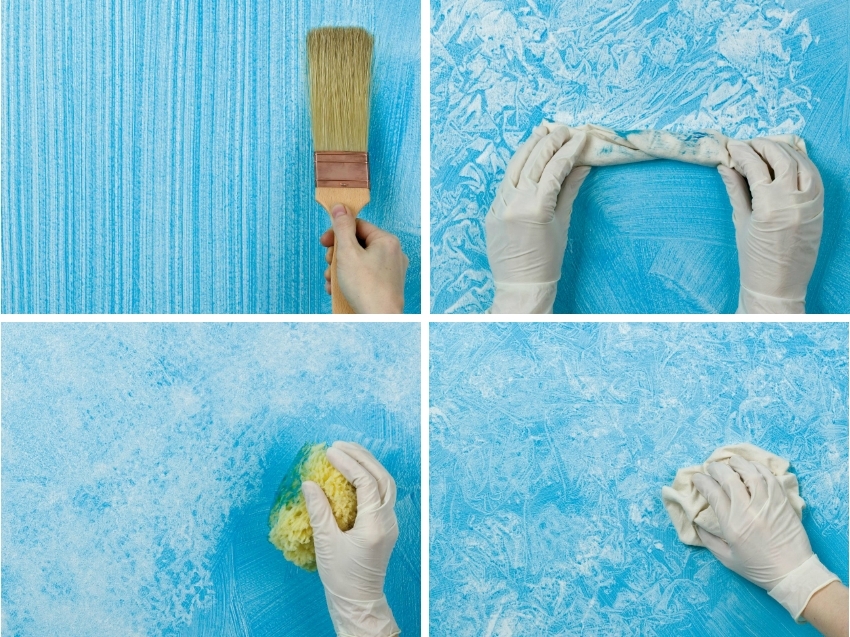
Examples of decorative wall decoration using acrylic paint and scrap materials
- a roller with a foam or fur sponge - used to obtain a uniform rough surface by rolling up and down the wall. The texture will depend on the structure of the sponge or the variety of its fur coat;
- curly roller - the tool has a relief surface with a pattern protruding outward, which is imprinted on fresh paint. So that the texture is not interrupted, it is advisable to process a section of the wall to its full height (from floor to ceiling);
- natural sponge, textiles or crumpled paper - use the "trimming" technology to work with these devices. In other words, with the help of the material, the freshly painted surface is stamped;
- trowel - painting is obtained by applying dye in two layers. To work with the first layer, you must use a spatula, and with the second - a trowel. One day after the finish is dry, the surface is covered with white enamel (matte) using a fur roller.
There are also alternative methods of applying texture: with your fingers (in rubber gloves), wrapping the roller with rags or rope (effect of bamboo stalks), blows with a wet rag, etc.
The procedure for preliminary preparation of walls for painting
Preliminary preparation of the wall for applying a structural dye is as follows:
- The floor and ceiling must be covered with foil to avoid splashing and dirt on the surface.You can use tape to fix the material.
- The wall is tested for vibration resistance, as this may result in dye shedding in the future.
- The old coating is removed from the wall and its surface is cleaned.
- A layer of plaster is applied in order to eliminate potholes and cracks.
- To improve the adhesion of the dye, the wall is covered with an acrylic primer. It is better to use a paint roller during work.
Important! The color of the primer must match the color of the dye. During work, care must be taken to ensure that the material is evenly distributed.
After applying the primer, the wall must be allowed to dry. This takes at least 5 hours. The drying time depends on the level of humidity and the temperature in the room.

Preparing the wall before painting is a guarantee of uniform paint application and a long-term coating that will remain resistant and bright for several years
Features of applying liquid decorative paint for walls in an apartment
Most often, when working with liquid textured dyes, a paint brush or roller, a foam sponge is used, less often a spray bottle (painting in one layer). You can wrap a rag over the roller. First you need to mix the material in the jar and dip the tool chosen for application there. During work, it is imperative to adhere to one technique so that the pattern turns out to be uniform and the same throughout the room, otherwise the result will not be aesthetic.
The dye is applied from top to bottom, so that stains that spoil the appearance can be avoided. The first coat is usually applied with a roller or brush. After it dries, you can use a curly or regular roller to paint the wall and paint a different color. It is allowed to use the palm or fingers instead of the tool. The result is an unusual effect.
It is recommended to start work from those areas where the room is poorly lit, there will be furniture or carpets hanging. If the hand is not yet full, possible defects in these areas will be invisible. The last layer of dye should be applied in the direction of the sun's rays.

Before painting, it is worth asking which particular tool is better to use - usually manufacturers indicate this information in product catalogs and on packages
Wall painting technology with decorative paint: the use of dry composition
To work with dry dye, you need to take a container for diluting and mixing the composition. The best option would be a bucket with a capacity of 10-15 liters. After that, you need to open the bag of dye and fill half of the container with it. If, as planned, the introduction of fillers into the composition is required, then a quarter of its volume is poured into the bucket. Then the dye is diluted with water in the ratio indicated by the manufacturer on the package.
Be sure to mix the composition thoroughly. It is better to use a construction mixer for these purposes. The dye is stirred for 5-10 minutes. In order not to move a heavy bucket throughout the room, you need to transfer part of the finished mixture to another container. It should be wider than the trowel.
If a filler with particles larger than 2 mm has been added to the composition, the dye must be applied with a flat trowel. For work with a mass that includes quartz or ordinary sand as filler, it is better to use a flat or notched trowel. The recommended tooth width is 1-2 mm. If you use a tool with wider teeth, the pattern will be too rough.
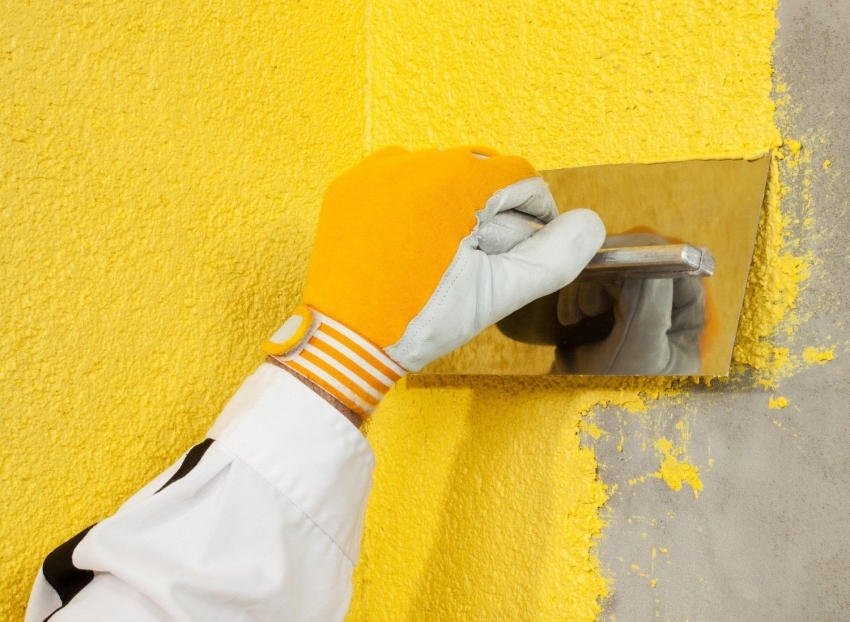
An example of applying a dry paint composition to a wall with the addition of large particles of polymers
Note! The recommended coverage area in one approach is 1-2 m². The initial hardening of the composition occurs within 10-15 minutes, after which it is no longer possible to accurately correct the pattern.
Application technique:
- A small amount of dye is collected with the instrument.
- With a smooth trowel, the composition is applied to the wall with up and down movements over an area of 1 m².
- The dye is leveled with a wide spatula in horizontal movements.
- The pattern is applied with a fine-toothed spatula or other tool.
You can use a narrow spatula (5-10 cm) to apply paint. In this case, the wall is painted with chaotic inclined, vertical and horizontal movements.
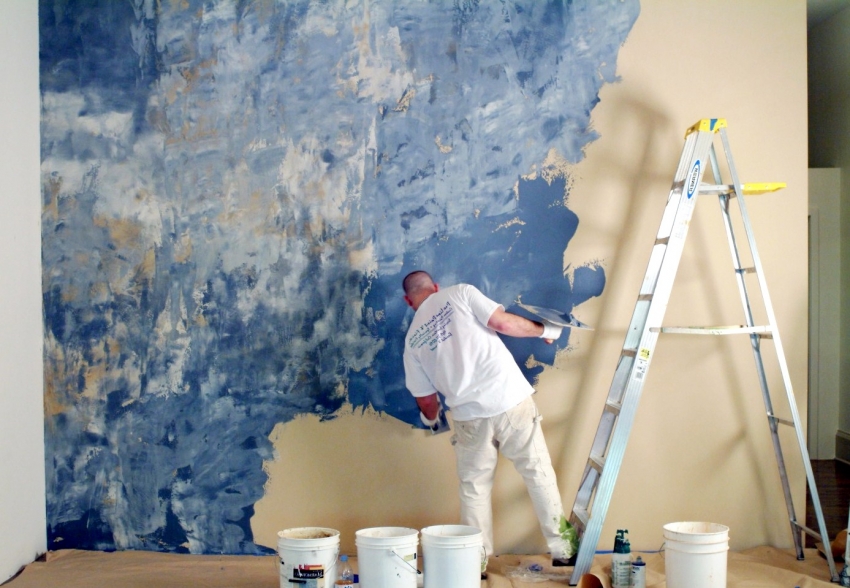
If it is necessary to paint the wall using several types of paints with different textures, it is better to involve a specialist in such work.
Methods for decorating paint for interior wall decoration
You can use different techniques to decorate walls painted with textured paint:
- stencil - a mold for work can be purchased in a specialized store or made by hand. For this, sheet plastic, linoleum or thick film are suitable;
- stardust - contrasting specks are applied in a different shade to the surface of the painted wall using a brush with stiff bristles. To do this, squeeze out the excess paint, bend the pile away from the wall and release it;
- contrast - a combination of contrasting shades looks attractive. The color variation can be either on different walls or on one (in the form of contrasting geometric shapes, for example, rhombuses, squares, etc.). To make the patterns even, it is recommended to use masking tape;
- aged surface - a dye of a contrasting shade is applied to the painted wall and worked through with repeated touches of a brush or sponge before the composition begins to dry.
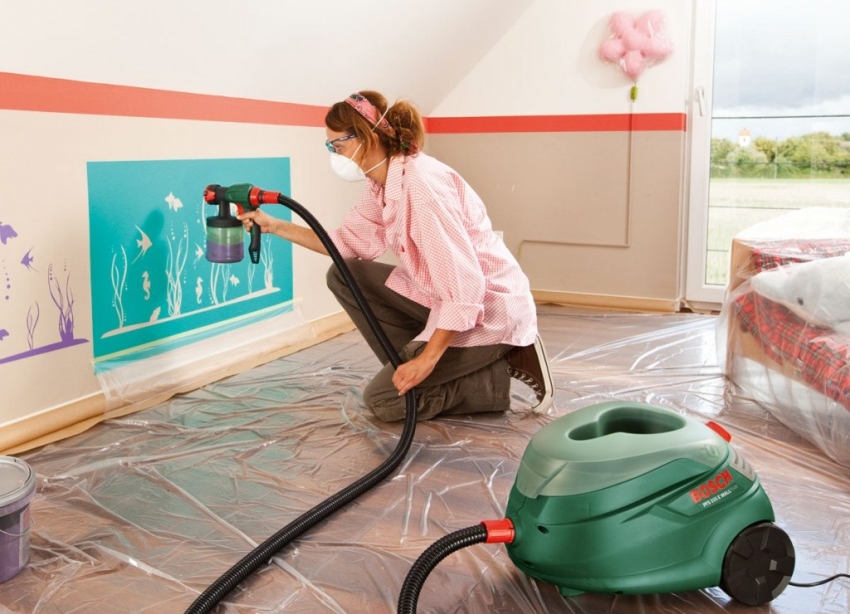
One of the most convenient ways to paint walls is to use a spray gun, but you should pay attention to the width of the nozzle when using textured paint with large particles
At the last stage, the surface is covered with interior varnish, which will enhance the expressiveness of the pattern. The methods of applying the dye do not end there. It all depends on the means at hand and imagination. The main thing is to observe safety precautions during work: use gloves, wear a hat and glasses to prevent dye from getting into the eyes.
